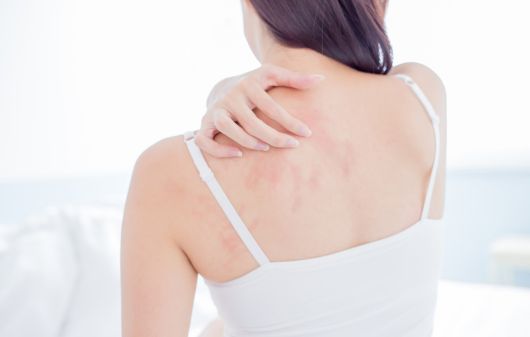
Get Eczema treatment online
Experiencing itchy, dry patches on your skin along with rash and redness can be bothersome and painful in some cases. It indicates eczema, also known as atopic dermatitis, which mainly occurs on the skin flexes and is caused by allergy triggers like dust mites, certain chemicals, or pet danders.
If you experience similar flare-ups anywhere on your body, consult a doctor at Your Doctors Online for the treatment and prescription of eczema.
How do I know if I have eczema?
Atopic dermatitis or eczema symptoms are as follows:
- Rash on swollen skin that varies in color depending on your skin color
- Small, raised bumps on brown or black skin
- Raw, sensitive skin from scratching
- Oozing and crusting
- Dry, cracked skin
- Thickened skin
- Itching
Causes of eczema
Eczema, a persistent skin condition characterized by itchy and inflamed patches, can arise from various underlying factors. Here are some of the most common causes:
- Infectious diseases: Certain infectious ailments like chickenpox and measles have been linked to eczema. Additionally, specific types of eczema may stem from viral infections, such as human herpes virus 6 (HHV6).
- Genetic disorders: The predisposition to eczema can sometimes be inherited. If a family member, particularly a parent, has eczema, there’s an increased likelihood of the condition manifesting in offspring.
- Immune system abnormalities: Individuals experiencing immune system dysfunctions, particularly during pregnancy or postpartum, may be more susceptible to eczema development. Conditions like preeclampsia and postpartum depression can contribute to this susceptibility.
- Bacterial infections: Certain bacterial infections, notably tinea capitis (ringworm infection) or tinea corporis (scabies), can result in eczema, particularly on the scalp or face. These infections are more prevalent among children but can be effectively treated with prescription medications.

Managing eczema: Treatment options
Finding effective treatment for eczema aims to alleviate symptoms, reduce inflammation, and, ideally, prevent flare-ups. A multifaceted approach is typically adopted, combining various treatments tailored to individual needs.
Prescription topical medications
These may include corticosteroids, and antibiotics. These medications are applied directly to the affected skin to alleviate symptoms and reduce inflammation.
Oral medications
In some cases, oral medications such as antibiotics, and steroids may be prescribed to manage severe symptoms or widespread eczema.
FDA-approved eczema medications
steroid
Learn MoreSteroid
Learn Moreantiparasite
Learn MoreAntifungal
Learn MoreAntifungal
Learn MoreAntiviral
Learn MoreSteroid
Learn MoreAntibiotic
Learn MoreHow to connect with doctor for Eczema
Connect with a health care professional online in 3 easy steps.
1
Describe your issue
Download our app, register and tell us about your medical issue to get started.
- Skin
- Sexual Health
- Obesity
- STD
- UTI
- Allergies
2
Chat with a doctor
Connect with a board-certified doctor. You can chat, send pictures and videos.
Hi I’m Dr. Nicole. How may I help you?
Hi Dr. Nicole, I have dry, itchy patches on the elbows and knees. Can you please help?
3
Get online prescription
Our online doctors can help you with your medical issues and give you prescriptions.
Prescription
- Hydrocortisone 1% Ointment
- Apply to the affected area once a day in the morning for a maximum of 4 weeks.
Send Prescription
Strategies for eczema prevention
While eczema may not always be entirely preventable, adopting certain measures can significantly reduce the risk or severity of flare-ups. Here are some preventive strategies to consider:
- Daily moisturizing: Regularly moisturizing the skin helps strengthen its barrier, reducing the likelihood of eczema flare-ups.
- Identifying and avoiding triggers: Recognizing and avoiding triggers like certain foods, environmental allergens, and stressors can minimize the risk of eczema episodes.
- Stress management: Stress-reducing techniques such as mindfulness, meditation, or yoga can help manage stress levels and alleviate eczema symptoms.
- Healthy lifestyle: Maintaining a balanced diet, regular exercise routine, adequate sleep, and avoiding smoking and excessive alcohol consumption contribute to overall skin health and may decrease the frequency of eczema flare-ups.
FAQs about Eczema treatment online
What is the best medication for severe eczema?
The best medications for severe eczema include cyclosporine, prednisone, mycophenolate, methotrexate, and azathioprine. These pills are unsuitable for long-term usage as they can have serious side effects.
What can cure eczema completely?
Eczema, or atopic dermatitis, is an allergic inflammation of the skin that can only be managed by treating the symptoms and reducing the exposure to the triggers. For instant relief and healing of eczema, topical corticosteroids can provide quick relief as they work on the inflammatory pathways reducing the inflammation and itching rapidly.
What can I use for eczema while pregnant?
Eczema flare-ups appear due to specific triggers that make your immune system reactive, resulting in inflammation and itching in the affected area. You can use mild corticosteroids, oral antihistamines, and gentle moisturizers per your doctor's advice.
Can you do telehealth for eczema?
Telehealth visits to online doctors can be beneficial for long-term eczema management. They offer convenience and accessibility in monitoring and treating the condition remotely with the availability to get prescriptions delivered to your preferred pharmacy without waiting hours in the queue.
How do I get prescribed eczema cream?
Dermatologists can prescribe various creams and treatments to address eczema symptoms and reduce flare-ups. You can receive personalized treatment options to manage your eczema effectively and alleviate skin inflammation by consulting with an online doctor.
What makes eczema worse in babies?
Babies' eczema aggravates with specific triggers like harsh detergents, high temperatures, woolen clothing, allergic foods, pet danders, and asthma. Dry weather can also increase the chances of eczema flare-ups in children. It's best to watch what they are allergic to and avoid the triggers as much as possible.
What triggers eczema on the face?
Harsh soaps, detergents, low-humid weather, woolen clothes, allergens trigger eczema, etc. Different people get eczema flare-ups due to different reasons.
What does eczema look like?
Eczema looks like a rash and can vary in color and intensity from purple, red, brown, or gray. It varies according to their skin tone and the intensity of the marks on the skin.
What is the most effective medicine for eczema?
Corticosteroids like hydrocortisone 2.5% and triamcinolone 0.1% are anti-inflammatory medications, effective in relieving eczema symptoms. By suppressing immune cell activity, corticosteroids interrupt the inflammatory process, providing relief from itching, redness, and swelling associated with eczema and dermatitis.
Is it bad to leave eczema untreated?
Eczema symptoms can occur at any age and may persist without proper treatment. Untreated eczema can lead to complications such as additional skin issues, mental health concerns, and sleep disturbances. It's essential to seek medical attention to manage eczema effectively and prevent potential complications.
What kind of doctor is best for eczema?
Dermatologists specialize in diagnosing and treating eczema. You can also consult an online GP to get a Prescription for the eczema treatment from the comfort of your home.
When should I get checked for eczema?
You should seek medical attention if your eczema symptoms persist despite using over-the-counter hydrocortisone creams for a week. Additionally, if you notice the formation of crusts or pus-filled blisters over existing eczema patches or have been exposed to individuals with viral skin diseases during an eczema flare-up, consulting a healthcare professional is recommended for proper evaluation and treatment.
-Phindile Mkhatshwa
-brooke snow
-Okiti Stephanie
-ASIF Khan
-Chelsey
-edith bien aime
-Lesego Thejane
-Stephanie Brown
-kulwinder gill
-Elijah Mark
Get started today
Talk to online doctors now and get medical advice, online prescriptions, refills, lab requisitions and medical notes within minutes. On-demand healthcare services at your fingertips.





